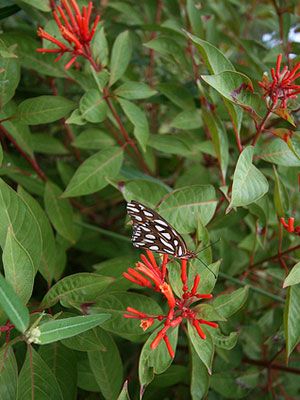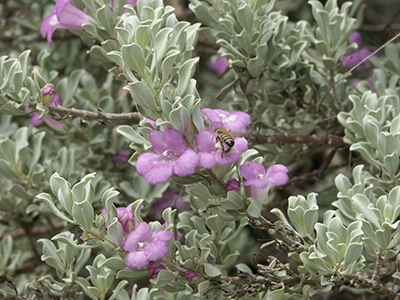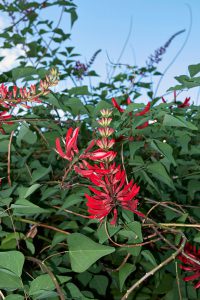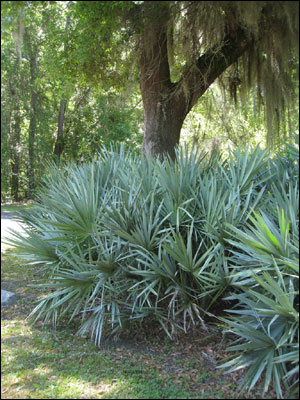A Shrubbery!
Fill your landscapes with diversity! Our vibrant landscapes should exude a mix of different groundcovers, perennials, annuals, shrubs, and trees. Landscapes provide tremendous value when we diversify the landscape. In the “Diversify the Landscape” series we have covered groundcovers and different annuals and perennials that we could include into our landscapes. Today’s article will cover a diverse collection of shrubs that will make the Knights Who Say “Ni!” and Roger the Shrubber proud.
It is important to note the with the Florida-Friendly Landscaping Program’s first principle, “Right Plant, Right Place”, there is no limit to the collection of plants within your landscape. Your only rule should be to select plants that thrive in the environmental conditions that you want to plant. Therefore, today’s list of shrubs includes Firebush, Texas Sage, Coralbean, Sweet Almondbush, and Bluestem Palmetto.
Firebush (Hamelia patens)
Firebush (Hamelia patens) is a Florida native that thrives from the United States Department of Agriculture (USDA) hardiness zones 9 – 11. This is one of my favorite native shrubs. The bright, showy flowers attract butterflies and hummingbirds throughout the entire warm season. Plant the Firebush in well-drained soils. It is very adaptable to light conditions but can do well in full sun to shade. However, the best blooms will occur in full sun conditions. The Firebush is a large shrub. If you are interested in dwarf cultivar, look for the ‘Firefly’ at your local gardening center.

Texas Sage (Leucophyllum frutescens)
A tough-as-nails plant that I love seeing within the landscape is Texas Sage (Leucophyllum frutescens). Texas Sage is a non-native, but it’s compact size and stunning purple flowers with pale green leaves are a landscape showstopper. This is a semi-evergreen shrub that thrives in your brutally hot and sunny landscapes. Texas Sage is commonly referred to as the “Barometer Plant” because it prefers to bloom shortly after rain events or during periods of high humidity. Plant Texas Sage in alkaline and well-drained soil. After plant establishment, this plant requires little attention.

Coralbean (Erythrina herbacea)
Coralbean (Erythrina herbacea) is a medium-sized, evergreen shrub that has an incredibly unique leaf shape, red colors, and seed pods. Plant within USDA zones 8-11 and in full-sun to partial-shade landscape. I recommend planting Coralbean in a naturalistic or informal landscape as a landscape or specimen plant. Additionally, this native plant has no major pests or disease concerns and attracts hummingbirds.

Sweet Almond Bush (Aloysia virgata)
Want a sweet fragrance in your landscape? Plant the Sweet Almond Bush (Aloysia virgata). This plant thrives throughout Florida, attracts butterflies, and produces fragrant flowers from summer to fall. This drought-tolerant plant prefers full sun, but once established it is very low-maintenance. If you have this in your landscape, deadhead between blooming cycles to increase the density of the plant.

Bluestem Palmetto (Sabal minor)
I love this plant…The Bluestem Palmetto (Sabal minor) should be a staple to Florida’s landscapes. This Florida native is very slow-growing but creates a beautiful massing or specimen plant for any landscape. I really love this plant. Most striking is its bluish-green leaf color, which creates a high contrast among your other plants. It also attracts all sorts of wildlife and pollinators to your landscape. This hardy plant could be a champion of any landscape if planted in full-sun to part-shade conditions but is adaptable to almost any soil condition. Did I mention that I love this plant?

Conclusion
Our landscapes are beautiful but can be environmental champions. By diversifying our landscapes with different plant choices, your landscape becomes an aesthetically pleasing environment that is teaming with life. Do not let this list feel like it is a conclusive list for plant selection, but rather, a list of plants that gives you ideas to diversify your landscape. What types of unique shrubs are you using within your landscape? Please let us know!
Other Articles in the Diversify the Landscape series
Landscape Annuals and Perennials
Interested in more gardening-related blogs or following Alachua County’s MGVs on Social Media? Check out the additional links from Dr. Clem.
UF/IFAS Alachua County Extension Master Gardeners, Facebook Page
UF/IFAS Extension Alachua County YouTube Page
 0
0
